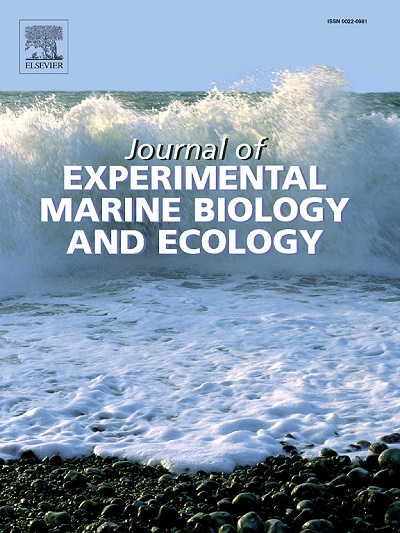Incubation duration and predicted hatchling sex ratios of leatherback turtles (Dermochelys coriacea) in the southwestern Atlantic Ocean (1988–2021)
IF 1.8
3区 生物学
Q3 ECOLOGY
Journal of Experimental Marine Biology and Ecology
Pub Date : 2025-03-27
DOI:10.1016/j.jembe.2025.152100
引用次数: 0
Abstract
Knowledge of sex ratios of species with temperature-dependent sex determination (TSD) is key to provide baseline information which can be used to inform management strategies and predictions of how climate change can affect populations. In marine turtles, increased incubation temperatures can lead to extreme biases in sex ratios and reduced hatching success. Here we present a long-term analysis (34 years) of incubation durations of leatherback turtles (Dermochelys coriacea) in Brazil, the only population of this species breeding in the Southwest Atlantic, and estimate offspring sex ratios. We deployed data loggers recording nest temperatures in 2015, 2016, 2017 and 2019 (n = 28 clutches), to predict offspring sex ratios based on incubation temperatures during the thermosensitive period when sex is determined. The overall mean incubation duration for leatherback turtle clutches in Brazil (1988–2021) was 66.3 days (range 52–91, SD = 6.4, n = 867), decreasing by 4.4 days between the first and last 10 years of monitoring and varying latitudinally across the nesting range of the population. When modelled to the overall nesting season and accounting for nesting seasonality, we estimated the current (2012−2021) mean season-wide primary sex ratio to be 46.9 % female (range 32.7 % to 84.8 %). Hindcasting for the first ten years of monitoring (1988–1997) showed the average predicted offspring sex ratios would have been 34.6 % female (range 7.7 % to 68.1 %). This population has not shown a phenological shift in the timing of nesting over the period 1988–2021. These findings suggest that, although the primary sex ratio of this population has likely become more female-biased in recent decades, the spatial and temporal variation observed demonstrates some resilience to the effects of increasing temperatures under climate change.
西南大西洋棱皮龟(Dermochelys coriacea)孵化期及预测孵化性别比(1988-2021)
了解具有温度依赖性性别决定(TSD)的物种的性别比例是提供基线信息的关键,这些信息可用于通知管理策略和预测气候变化如何影响种群。在海龟中,孵化温度的升高会导致性别比例的极端偏差和孵化成功率的降低。在这里,我们对巴西棱皮龟(Dermochelys coriacea)的孵化时间(34年)进行了长期分析,巴西是西南大西洋唯一的棱皮龟种群,并估计了后代的性别比例。我们部署了数据记录仪,记录了2015年、2016年、2017年和2019年(n = 28窝)的巢温,根据确定性别的热敏期孵化温度预测后代的性别比例。1988-2021年,巴西棱皮龟卵的总体平均孵化期为66.3天(范围52-91,SD = 6.4, n = 867),在监测的头10年和最后10年之间减少了4.4天,并且在种群筑巢范围内呈纬度变化。当建模到整个筑巢季节并考虑到筑巢季节时,我们估计当前(2012 - 2021)整个季节的平均主要性别比例为46.9%(范围为32.7%至84.8%)。监测的头十年(1988-1997)的预测结果显示,平均预测后代性别比为34.6%为雌性(范围为7.7%至68.1%)。在1988-2021年期间,这个种群在筑巢时间上没有表现出物候变化。这些发现表明,尽管近几十年来,该种群的主要性别比例可能变得更加偏向于女性,但所观察到的时空变化表明,在气候变化下,该种群对温度升高的影响具有一定的适应能力。
本文章由计算机程序翻译,如有差异,请以英文原文为准。
求助全文
约1分钟内获得全文
求助全文
来源期刊
CiteScore
4.30
自引率
0.00%
发文量
98
审稿时长
14 weeks
期刊介绍:
The Journal of Experimental Marine Biology and Ecology provides a forum for experimental ecological research on marine organisms in relation to their environment. Topic areas include studies that focus on biochemistry, physiology, behavior, genetics, and ecological theory. The main emphasis of the Journal lies in hypothesis driven experimental work, both from the laboratory and the field. Natural experiments or descriptive studies that elucidate fundamental ecological processes are welcome. Submissions should have a broad ecological framework beyond the specific study organism or geographic region.
Short communications that highlight emerging issues and exciting discoveries within five printed pages will receive a rapid turnaround. Papers describing important new analytical, computational, experimental and theoretical techniques and methods are encouraged and will be highlighted as Methodological Advances. We welcome proposals for Review Papers synthesizing a specific field within marine ecology. Finally, the journal aims to publish Special Issues at regular intervals synthesizing a particular field of marine science. All printed papers undergo a peer review process before being accepted and will receive a first decision within three months.

 求助内容:
求助内容: 应助结果提醒方式:
应助结果提醒方式:


